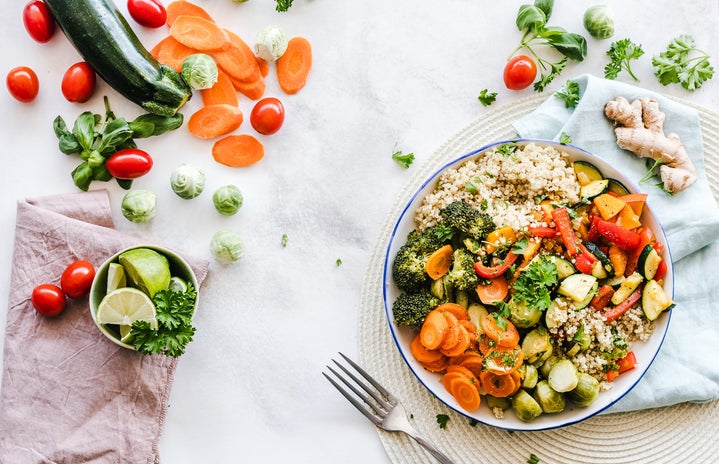College is a time to try new things, including trying new workout routines or sports. The University of Connecticut introduces many different opportunities to its students, like Dance Fit or Spin classes sponsored by the Rec Center, giving everyone the opportunity to find a fun way to work out. Being away at college can be an inspiration to change one’s lifestyle. Since I have been at UConn, both my exercise and food habits have changed dramatically, and because of this it is important to focus not only on staying active but also on pairing food intake with exercise intensity. Below, I researched the diets of iconic female athletes. I also interviewed registered dietitian Lynn Kula for more information.
Serena Williams
Serena Williams is iconic, strong, and inspirational to all women. Her mind-blowing talents on the tennis court leave her fans speechless, but how does such a strong woman maintain the fitness to make these astonishing feats possible?
Williams has both a vigorous workout routine, but also a healthy and substantial diet. Williams consumes a raw vegan diet, and to obtain her nutrients she eats foods like nuts, beans, lentils, and quinoa. Here is Williams’ average daily diet:
Breakfast: Oats with strawberries, tangerines, and almond butter.
Snack: Almond butter sandwich using a type of bread made with sprouted seed flour.
Lunch: A salad with lettuce, spinach, oranges, cherry tomatoes, lime juice, onions, pita croutons, and almonds.
Dinner: Brown rice with hemp and chia seeds, and salads with fresh vegetables.
Williams consumes a substantial diet that is rich in nutrient dense foods, which is a vital component of her athletic success.
Simone Biles
Simone Biles is a household name in America. As a gold medal Olympic athlete, she is an inspiration to countless people around the world. Her strength and talents as an Olympic gymnast are astounding, but for Biles to attain this level of fitness, she not only needs to maintain a regular and intense workout routine but also a consistently nutritious diet with sufficient amounts of energy content. Here is what a typical day of eating looks like for Simone Biles.
Breakfast: A protein waffle with fruit.
Lunch: She usually has a lunch with high protein and fiber like chicken and vegetables.
Snack: Plantain chips for their fiber rich qualities.
Dinner: She usually consumes nutrient dense foods such as fish with vegetables and rice.
Biles incorporates a lot of healthy nutrients into her diet consistently in order to build the strength that allowed her to become a nationally recognized Olympic athlete. Without her nutritious eating, she would not have the energy or nutrients to allow her body to obtain the strength she now has.
Lindsey Vonn
Lindsey Vonn was competing in the Olympics for skiing by the age of 17, younger than most of the students here at UConn. Vonn put in a tremendous amount of work to make her dreams become a reality, but the foods she incorporated into her diet also played a large role in her success. Vonn was able to build up strength by tailoring her diet to her workout routine. Her food choices would vary based on the workout she planned for the day. Here are some examples of the foods she consumes based on her exercise plan.
Breakfast: If she planned to do cardio, she would have a banana with almond butter; if she planned on lifting, she would have eggs with avocado; if she planned to ski, she may have steel cut oats with fruit.
Post workout snack: Protein shake with fruit, almond butter, and beet powder.
Lunch: Salad with protein added, maybe in the form of chicken.
Dinner: Protein such as salmon along with a salad. She also adds goat cheese and vegetables.
When engaging in intensive exercise, nutrition is a vital aspect to ensure muscle development and discourage the loss of muscle. If an insufficient amount of nutrients is consumed to support one’s exercise, then the body will utilize muscle proteins as a source of glucose to be used for energy, leading to the loss of muscle mass. Vonn’s diet ensures that she gets enough nutrients as she puts emphasis on eating in order to complement her exercise. Although many of us are not committed to the level of training these athletes demonstrate, their exercise and diet habits serve as an example of how exercise and nutrition are not separate components of health, rather they rely heavily on each other.
What Does a Registered Dietitian Think?
With high endurance and intensity activities, comes the need for substantial nutritional resources. I interviewed registered dietitian Lynn Kula and we looked into the types of foods best for trying to build muscle and make healthy lifestyle decisions.
To build muscle, Kula emphasized the importance of consuming high protein foods to repair the muscles that break down during exercise. These proteins, while found in meats, are also attainable for those with a vegan or vegetarian diet. Foods like yogurt, cheese, or milk also contain proteins that promote muscle growth.
Another important aspect that Kula brought up in terms of nutrient intake in relation to exercise is the fact that many people who workout are deficient in nutrients such as B vitamins, and such deficiencies lead to fatigue. Protein is well known for its benefits in building muscle; however, B vitamins are also crucial nutrients that benefit muscle functioning, and these nutrients can be found in fruits and vegetables.
Not only is it important to consider the quality and content of food consumed, but also the times, especially in terms of exercise. Kula explained how eating after intense exercise is important for repairing muscles, so there should be a focus on eating protein foods after a workout. Many advise consuming protein about 30 minutes to an hour after a workout.
In college, it can be difficult to make healthy choices about food intake, but not impossible. Kula said that when choosing meals, try to incorporate more fresh fruits and vegetables and less processed foods. For example, a stir fry is a food she recommended that provides both protein and vegetables that benefit muscle functioning.
It’s okay for diet and exercise patterns to change, but it is also important to be attentive to warning signs your body may send if exercise intensity is not balanced with food intake. If there is an imbalance between input versus output of energy, an individual may experience a decrease in their performance abilities when working out or may feel an increase in fatigue during and after working out.
My Experience
When trying to get into shape it’s easy to just focus on the exercise portion of this process, but if diet is given no consideration, then muscle may not build as anticipated. I started running competitively in high school, and the importance of a substantial diet became clear through experience. Jumping right into running without altering my eating habits inhibited me from building strength or endurance, but when I increased my intake of proteins and carbohydrates, I was able to perform better. Diet and exercise can be difficult to manage, but focusing on your exercise intensity and incorporating nutrient-dense foods into the diet, will help the body grow to its full potential.


